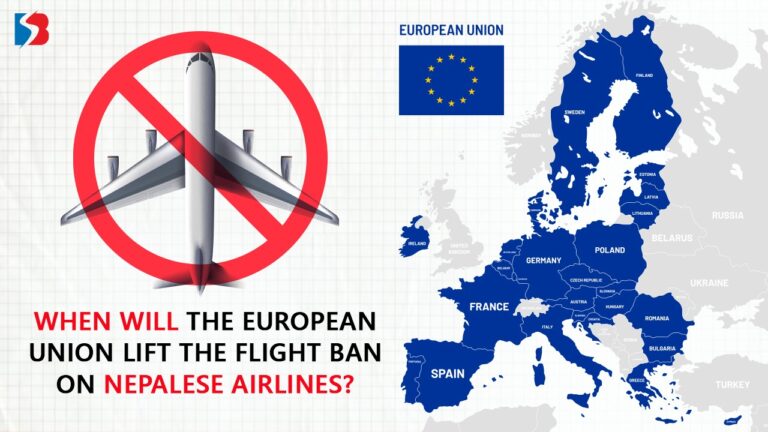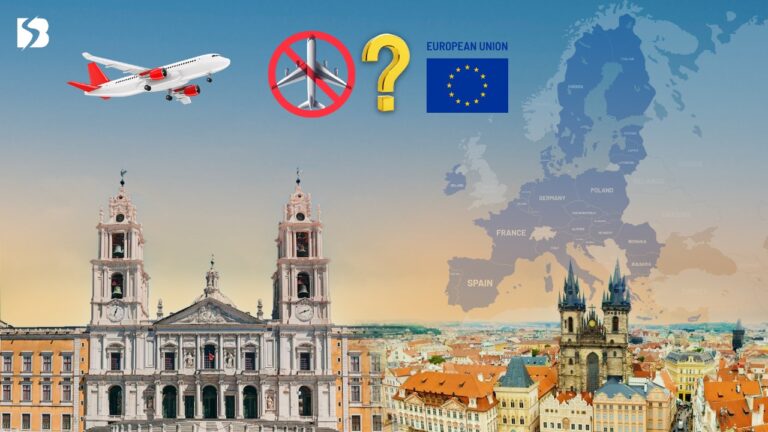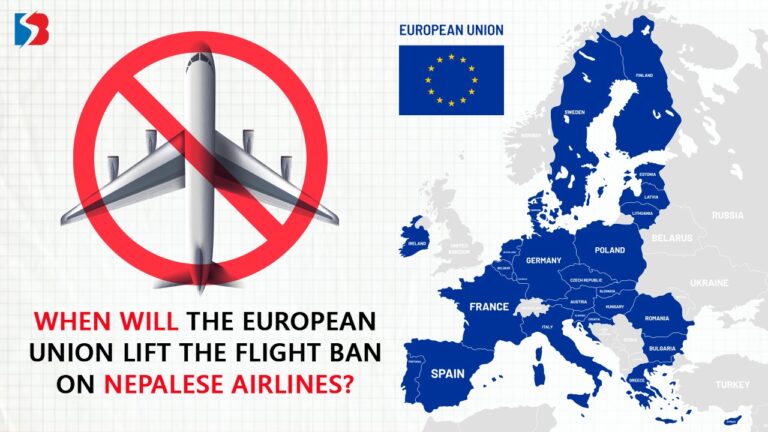
In 2013, ICAO placed Nepal’s airspace on the list of “Sensitive Security Concerns” (SSC) citing dissatisfaction with the level of air safety standards. Based on that, the European Union banned Nepal’s air service from operating in its skies. Although the ICAO delisted SSC in 2017, the EU ban is still in place.
Even though ICAO removed Sensitive Security Concerns (SSC) from the list, why didn’t the EU remove the flight ban?
Since 2013, the European Union (EU) has put Nepal on the air ban list. In the last 10 years, there have been 20 fatal air accidents in Nepal. In 2010, there were three plane crashes in the same year, one in 2011 and two in 2012. The ban was imposed based on that accident. One of the main reasons for the ban was the many helicopter crashes in Nepal before that.
The EU based the ban on the report of the International Civil Aviation Authority (ICAO). In 2013, ICAO placed Nepal as a country of serious security concern, raising questions about air safety. ICAO removed it from the list seven years ago in July 2017.
Gyanendra Bhul, co-spokesperson of the Civil Aviation Authority of Nepal, the regulatory body of Nepal’s aviation sector, says on this matter. “The EU imposed restrictions based on the regulations made by ICAO, but even when ICAO removed it from the list of serious security concerns, it was surprising that the EU did not lift the restrictions.”
The Civil Aviation Authority of Nepal conducts the audit of airline companies registered in Nepal. Not only that, the authority is responsible for regulating the flight from any country of the world to Nepal from safety oversight until it flies in Nepal’s skies and stays at the airport. The audit of the authority is done by the International Civil Aviation Organization (ICAO).
ICAO conducted its first audit in Nepal in 2009. What is the structure of the authority, how does the authority operate and regulate its subordinate structures, as well as operations related to air safety and compliance with the rules, when audited based on 8 criteria, Nepal scored only 43 percent out of 100 percent.
When audited again in 2013, it got 55 percent marks. However, ICAO said that 60 percent marks should be obtained. Accordingly, while making improvements as stated by ICAO, in 2017, the standard implementation rate was above 66 percent, and Nepal also received the ‘Presidential Award’ from ICAO. Similarly, in 2022, the compliance rate of this standard has increased to 70.10 percent. ICAO has recently praised the Nepalese aviation sector for its good compliance rate.
Due to the restrictions imposed by the EU, the Nepal Airlines Corporation was not allowed to carry out rescue flights for the citizens of European and North American countries when the situation of the COVID-19 epidemic became serious. Jagannath Niraula, the spokesperson of Nepal Civil Aviation Authority, argues that even though significant progress has been made in aviation security recently, the reason why it has not been removed from the EU’s ban list is not understood and now diplomatic initiatives should be taken from the government level.
Due to many ship accidents from 2010 to 13, ICAO placed it on the safety list and the EU also banned it. However, Niroula says that there is no reason why the EU should not remove the sanctions after the significant reform.
The European Aviation Safety Agency (EASA), the aviation regulatory body of the European Union, has mentioned the problems of the Nepalese aviation sector in its report. :
On November 29, 2023, the EU in Nepal decided not to remove Nepal from the security list because it is not satisfied with its current capacity to fulfill the responsibility of implementing the minimum international security standards. According to the EU, it has been pointed out that the authority’s capacity to implement international safety standards is insufficient.
Evidence gathered from the EU’s on-site assessment, observation visits, etc., suggests that the authority’s ability to oversee aviation activities in Nepal is incapable of enforcing and enforcing minimum international safety standards. It emphasizes the need for further improvement in the supervisory capacity, staff management, staff training, and certification processes of the Civil Aviation Authority of Nepal (CAN).
Main issues raised:
A. There is no coordination between the approved structure and practicality of the Civil Aviation Authority, which shows that a comprehensive organizational restructuring is required.
B. The authority’s current standards for issuing permits to aviation-related persons and the flight inspection system are not by international safety standards. In the case of helicopter flights, there is no such structure. There is no clarity between the effective inspection and training of the authorities issuing such permits in the authority.
C. There is a problem in the regulation and approval process of the Flight Operations Division of the Authority which looks at the limits of working hours and fatigue. There is a structural problem in the Flight Operations Division regarding keeping details of flight safety and giving certain approvals.
D. The department responsible for monitoring lacks maturity in important matters such as testing, training, and review of documents.
E. The aspect of traffic management at the airport has also been raised in the report.
In the report, it is mentioned that the authority has identified the root of the problem, and has committed to solving the issues raised in the past, but it is said that it is insufficient and has not been implemented. Similarly, the weaknesses of the flag carrier corporation and Shree Airlines have also been pointed out. Regardless of any other weaknesses pointed out, the knot of the European Union’s restrictions does not seem to be loosened until the organization of the Civil Aviation Authority through the organizational restructuring of a separate service provider and a separate regulator.
Nepal Civil Aviation Authority and experts have different views on the arrangement of a separate regulator:
According to Jagannath Niraula, the spokesperson of Nepal Civil Aviation Authority, who is not aware of why the bill is being brought, CAN does not know and the government will make it work as the law is brought. Whether to make the service provider and the regulator the same or not and why the bill that was brought to be made is stuck, the government is not going to be accountable and take the initiative to do the reform work quickly internally.
Likewise, a board member of the Civil Aviation Authority of Nepal and an expert in the aviation sector Achyut Raj Pahadi says that Authority should not be divided. He says that instead of breaking the Civil Aviation Authority of Nepal (CAAN), the supervision and regulation done by the CAANs should be made effective so that the compliance rate of the safety standards is better. The problem cannot be solved by dividing the CAN’s. ‘
However, the former general manager of Nepal Bioservices Corporation and senior captain KB Limbu says that the regulatory body and the service provider cannot be the same. Are they stupid or are we scholars? It is too late to arrange for different agencies to do the work of regulators and service providers.

A bill to break up the Civil Aviation Authority, which would provide separate arrangements for service providers and regulators, has stalled :
The International Civil Aviation Organization and the European Union have been suggesting institutional reform for a long time as there will be a conflict of interest when air services are regulated and provided by the same body in Nepal. Although the ‘Nepal Civil Aviation Authority Bill 2076’ and the ‘Nepal Air Service Authority Bill 2076’ were registered in the Parliament, both the bills were passed by the National Assembly a year ago and have not been able to proceed to the House of Representatives. Those bills were inactive as the term of the House of Representatives expired on October 1, 2079. RPP leader and MP Dr. Dhaval Shamsher Rana has said that the bill is stuck due to selfishness. Emphasizing that it should not be delayed and should be passed immediately, he says that ‘the service provider and the regulator cannot be the same body and when that happens, credibility is questioned’.
The idea that service providers and regulators should be separated before the EU is Nepal’s thinking :
This matter has been promoted by the government since 2007. The decision to separate the service provider and the regulator was made before the EU and ICO included Nepal in their air safety list. When the EU service provider and regulatory body are the same, there is no talk of dividing the authority just by pointing out the problem. Nepal signed a loan agreement with the Asian Development Bank to invest in various airport projects in 2010, committing to divide the civil aviation body into service providers and regulators. In addition, the aviation ministers at different times have been making commitments to separate the air safety monitoring bodies of ICAO and EU as service providers and regulators. The international body seems to be emphasizing the immediate implementation of this high-level commitment.
What is its loss in Nepal’s business sector?
Officials say that even though the image of our country’s air sector in the international arena has deteriorated due to the sanctions imposed by the EU, there is no business loss. Buddhi Sagar Lamichhane, joint secretary of the Ministry of Aviation, has said that our country’s international flights are not able to fly to EU member countries, so we did not have to suffer a huge loss, but even though tourists have not stopped visiting Nepal, when government officials from EU member countries come to visit Nepal, our country’s ships do not board.
What other countries have the EU put on the list of air restrictions?
The European Aviation Safety Agency (EASA), the aviation regulatory body of the European Union, has established Nepal as well as Afghanistan, Belarus, Angola, Democratic Republic of Congo, Republic of Congo, Djibouti, Equatorial Guinea, Djibouti, Eritrea, Iran, Iraq, Kyrgyzstan, Liberia, Libya, Pakistan, Russia, Sao Tome and Principe, Sierra Leone, Sudan, Suriname, Venezuela, Zimbabwe are also on the list of restrictions.
It seems that the government should take the initiative to take diplomatic initiatives with the EU, including the implementation of high-level political commitments. When Nepal’s entire airspace has returned to its pre-Covid status and there is talk of operating the international airport on a new model, such restrictions may hurt long-term plans that can benefit in the future.



 About Us
About Us
Comment